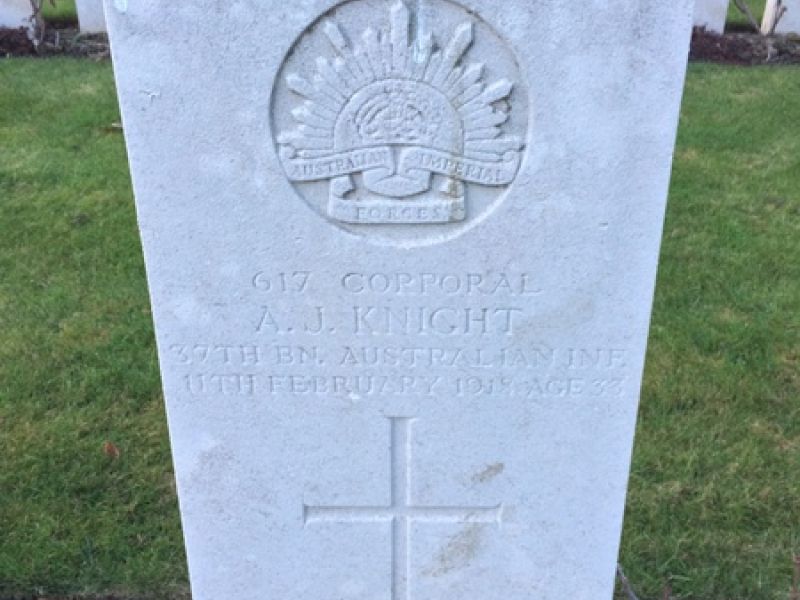Albert John (Jack) Knight
Albert John Knight was born in 1883 in Adelong, NSW. He was the tenth child of George and Mary Ann (née Williams). At the age of 14, one of his older brothers, Thomas, died, while ten years later his father, George, passed away.
Jack was a single, 32-year-old labourer living in Corryong, Victoria, when he enlisted in the 1st AIF at Tallangatta in February of 1916. He was allocated service number 617 and placed in the 37th Battalion. Every soldier was expected to make a will before heading overseas. In John’s will, he appoints Matilda Julia Sheather (one of John’s sisters) as the executor, passing on all of his estates to his mother, Mary and, if she should pass away, then to his sister, Mary Ann Louisa Gahon of Batlow in NSW. He lodged his will with Mr Hood, a solicitor in Corryong.
After initial training at Seymour, Victoria, the 37th Battalion embarked on board HMAT A34 Persic at the Port of Melbourne on the 3rd of June, 1916. Most of the 37th Battalion landed in England on the 25th of July, however, not Jack. While the Persic was resupplying at Capetown in South Africa on the 30th of June, he was selected to be part of a shore patrol to ensure that all was well with the visiting troops and the locals. Unfortunately, he literally missed the boat. Jack embarked on the next troopship, HMAT A62 Wandilla, and disembarked at Plymouth one day after the Persic had birthed. There is no record of him being disciplined for missing Persic's departure, so we can conclude that perhaps it was due to a situation beyond his control.
Upon arriving in England the battalion was sent to No 5 Camp, Lark Hill, situated on the Salisbury Plain in Wiltshire. Other than going through a program of intense training for trench warfare, the battalion was also inspected by the GOC (General Officer Commanding) of the 3rd Division, the GOC of the 10th Infantry Brigade and was standing with the 3rd Division when inspected by King George V.
Finally, the battalion embarked at South Hampton on the 22nd of November, 1916, to join the front. Upon arriving in France, they proceeded through Havre, Baileul, and Strazelle before arriving at Armentieres. By the 30th of November half of the battalion had taken up duties in the trenches at the front line. The month of December saw the 37th Battalion rotating through the trenches, billets, training and trench raids.
After spending a period of three weeks during February and March of 1917 in the 7th Australian General Hospital, suffering from the mumps, John returned to his unit. The 8th of June saw Jack being promoted to Lance Corporal, with a further promotion to Corporal in early November. He was given two weeks' leave to England from the 5th of January to the 19th of January, 1918.
Upon arriving back from his furlough in England, Jack found that his battalion was in reserve in the Neuve Eglise sector. On the 27th of January, the 37th Battalion relieved the 21st Battalion in the Warneton sector. Things were reasonably quiet here and the 37th suffered only seven casualties, 3 ORs (other ranks) killed and 4 wounded, during the month of January. In early February one officer and 25 ORs from B Company underwent training for a trench raid that would occur on the night of the 10th/11th.
The 37th Battalion War Diary for the 11th of February 1918 states;
“At 10 pm “minor operation” was carried out against enemy trenches, by composite party of 37th and 38th Btns, each Btn supplying 4 off[icers] 100 OR [other ranks]. The great was a great success, 33 prisoners were captured and a normal (228 RIR) identification established.”
Jack was a member of the party from B Company who made up the right flank assaulting team. Initially, they met strong resistance but, although several groups had to fight their way to the final objective, the party reported that they were “all in” by 10:06 pm. Several dugouts in the enemy’s second line were bombed with phosphorus, Stokes bombs and demolition charges. The casualties of the 37th Battalion for this patrol included 17 wounded, 2 killed, 2 died of wounds and 11 missing. One of the missing officers was Lieutenant William Crowe, a man also associated with Corryong.
Corporal Abert John Knight was wounded during the encounter, suffering from gunshot wounds in the back. These could have happened in either the close-in fighting within the enemy's trenches or as the party retired back across no-man's land. Jack was taken back by stretcher to the 10th Field Ambulance but succumbed to his wounds that day.
The following day he was laid to rest in the Pont Dechelles Cemetery by the Revd. H Pewen of the 3rd Division. In June of 1918, John’s mother, Mary, received two small packages. They contained all of Jack’s worldly possessions. The first contained 2 books, a curio and a brush. The second contained a testament, a metal ring, unit colour patches, a photo, a holdall, a comb, a razor blade and 2 badges. Three years later she would receive a photograph of the original cross put over Jack’s grave.
Jack is remembered at the Australian War Memorial Roll of Honour, the Corryong War Memorial, and his mother’s headstone in Corryong Cemetery. For his service, he was awarded the British War Medal and the Victory Medal.

 Stephen Learmonth
Stephen Learmonth